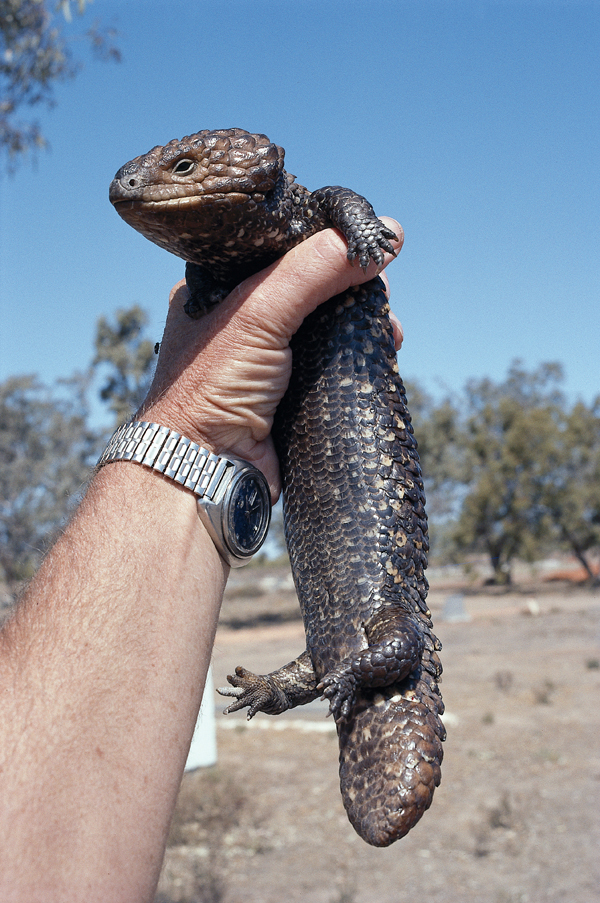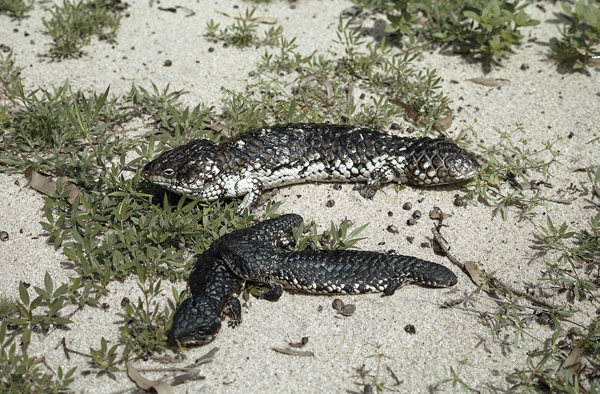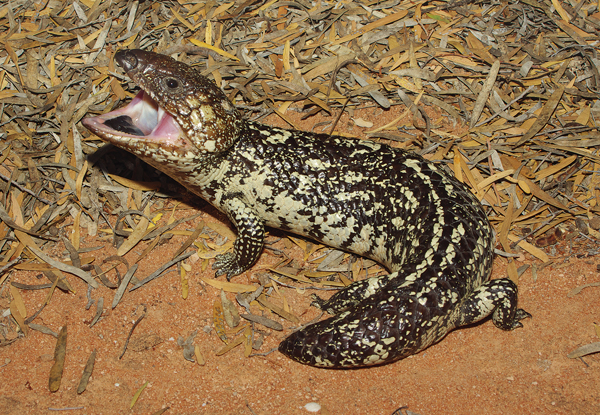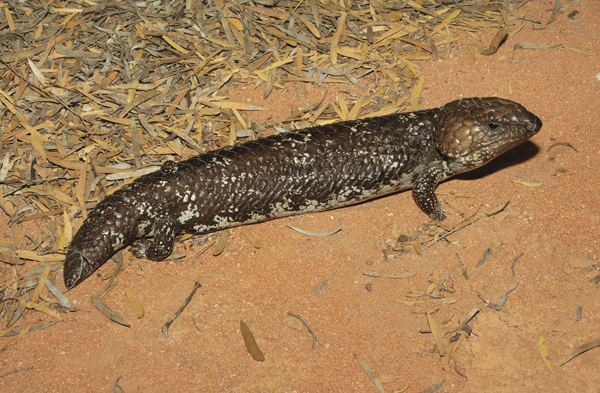Shingleback, shingle-back skink, pinecone lizard, stump-tailed skink, bobtail, sleepy lizard or just plain “stumpy” are all names that ide
Shingleback, shingle-back skink, pinecone lizard, stump-tailed skink, bobtail, sleepy lizard or just plain “stumpy” are all names that identify one of Australia’s reptilian icons. Scientifically, we know it as Trachydosaurus rugosus, but a few authors refer to it as Tiliqua rugosa. As is often the case, the scientific classification is under debate. Four subspecies are presently recognized, three of which occur in western Australia only. These are the western shingleback (Trachydosaurus r. rugosus), the northern shingleback (T. r.palarra) from the Shark Bay region, and the Rottnest Island shingleback (T. r. konowi). The eastern variety is T. r. asper. All are variable in color and pattern, meaning they are not always easy to tell apart.
Read More
Some of the best-known and most-common lizards in Australia, “stumpies” are broadly distributed over the southern half of the continent, though they are absent from the coast and mountain ranges of eastern and southeastern Australia. Habitats vary greatly, ranging from desert grasslands and spinifex-dominated regions, to eucalyptus scrublands and coastal heathland in west Australia.

Karl-Heinz Switak
The author found this shingleback skink in the Bourke City Cemetery in Australia.
Trachydosaurus is a large and bulky lizard, propelling itself along on somewhat spindly legs. Adults reach a total length in excess of 14 to 18 inches, with the eastern variety said to outstretch all the others. However, one I found in western Australia not only displayed a rich coloration, but it was of such impressive size that I called it “Big Red.” Some have a rather stubby tail (hence the common name “bobtail”), while the tail of others is longer and less broadened. Fat is stored in the tail during times of plenty, at which time it appears full-bodied. After hibernation, or following lengthy inactivity due to inclement weather or extended droughts, said appendage tends to appear longer than wider; variations are numerous. Body scales are rugose, most noticeably on the back, head and dorsally on the tail; such a reptilian coat is responsible for the name “pinecone” lizard. The head is large and equipped with a set of powerful jaws. Although normally docile, shingleback skinks are capable of inflicting a painful bite when threatened.
The young are born alive, but only two in a litter; occasionally, only one, and very rarely three, result from a litter. At birth, they measure approximately half the size of the female, demonstrating that carrying more than two progenies in her womb borders on the realm of impossibility. Being born of such large stature in the spring, when food availability tends to be widespread, allows the young to gain plenty of weight prior to facing leaner times later in the year, or during extended periods of drought that are so common to the Australian outback.
Australian Shingleback Skink Outback Introduction
My introduction to this marvelous lizard took place during my maiden voyage to Australia in January of 1970, when three dear friends—late Graeme Gow (snake expert), John Cann (turtle expert) and Steve Swanson (lizard expert)—showed me the outback in minuscule detail. Our goal was the sleepy community of Wilcannia, located some 600 miles west of Sydney. It lies at an elevation of 246 feet, with summer temperatures often reaching well above 100 degrees Fahrenheit. Winters, however, see the mercury plummeting to at least 42 degrees.

KARL-HEINZ SWITAK
Several T. rugosus asper that were found together.
Our choice for sleeping accommodations consisted of a dilapidated building, once part of a raceway. We had a roof over our heads, were somewhat protected from the wind, and I was promised that stumpies could be found in all directions. What more could I have asked for?
The following morning, just after sunrise, we set out to find our reptilian quarry. It didn’t take long. Several lizards were found under pieces of tin that were once part of the raceway’s structures. I recall how my heart skipped a beat, and how my adrenalin raced like a Corvette Stingray, when I lifted a tin and found an adult T. r. asper snuggled into a sandy depression with eyes still shut. Graeme and John also came up with one each, but I believe Steve found two. From the very first moment that I held one of these reptilian gems in my hands, I knew it would end up on my list of all-time favorites.
It wasn’t until October of 1982, Australia’s beginning of spring, that I returned to Wilcannia. This time, my dear friend Gary Pugh, fellow reptile lover and a person with unending enthusiasm in the field, agreed to join me. On our way to Wilcannia, we noticed a vehicle up in a tree with beckoning writing on it: “Bush Pub 6km. Cold Beer. Open Fire Steaks, $2. Bed-Breakfast, $7. Petrol.”

KARL-HEINZ SWITAK
A northern shingleback postures in warning.
“We better check this out on our way back,” I suggested to Gary, and of course, he agreed without hesitation.
Prior to reaching Wilcannia, even before crossing the Darling River, we came across an adult Gould’s monitor (Varanus gouldii) and plenty of large bearded dragons (Pogona vitticeps). The bearded dragons were easy enough to approach, but the monitor took off like greased lightning. More important, however, was the fact that an adult stumpy meandered slowly from one side of the road to the other.
In town, we rented a room, and then drove out to the abandoned race track I knew so well. More walls had tumbled and the roof was no more. We spent more than an hour there, turning scattered tins, boards and a few rocks, but only came up with two adult stumpies.
Returning to town, but somewhat off the beaten path, we located two broken-down buildings with plenty of tins and a few boards scattered here and there. After turning most of it, parting with a pound of sweat each, brushing spiders off our clothing and cursing the odd scorpion, we came up with 12 stumpies—that’s right, 12! Under one tin alone, I located two adults and a very healthy looking youngster. First, our thought was to relocate the lot, but then we decided against it. From all indications, the township seemed in no hurry to clean up anything.
An Outback Oasis
On the way back to Sydney, we made good on our promise and checked out the Bush Pub. En route, we came across an additional 17 adult stumpies, all crossing the road in what might best be described as sandy scrub desert, but also areas covered with eucalyptus trees and extremely parched vegetation. Almost ready to take the dirt road leading to the Bush Pub, I locked up the brakes for a large lizard on the road. It turned out to be a gorgeous adult lace monitor (V. varius). Unfortunately, it was DOR.

KARL-HEINZ SWITAK
Trachydosaurus is a large and bulky lizard, propelling itself along on somewhat spindly legs.
A few minutes later, we were parked in front of the rustic Bush Pub and wasted no time entering. First order of business was a glass of ice cold beer. Looking to my right, at the end of the bar, I noticed a stuffed bird, but when it gave us a flirtatious wink, I knew it wasn’t stuffed after all; we were looking at a very tame and sizable frog-mouth owl.
Next, we rented a small room (without AC, of course), and around noon, prepared one of those juicy steaks over the open fire, known as a “barbee” to the Aussies. Looking at a 250-pound rancher with the words “barbee” crossing his lips definitely had a comical ring to it. Gary and I made sure not to dwell on this subject.
The Stumpy Race
Finally, an event took place that was definitely to our liking. It involved a “stumpy race,” with excessive betting on the side. An aboriginal boy had been sent out to collect about a dozen shinglebacks earlier, and now, each animal was marked with white paint so that you knew which beast you were betting on. One had a bar across the back, another two bars, one a large dot on its head, and so on. A large area next to the pub had been cleared of obstacles and surrounded by a rope configured into a circle. In the center, the young boy now dumped all of the lizards at once, and from then on, the coaxing, screaming and swearing began. Once the fastest lizard reached the rope, the race was over. Believe it or not, shinglebacks are capable of moving fairly quickly (about the same speed as a blue-tongued skink). Now bets were either collected or paid off, and within minutes, there was standing room only in the pub. The stumpies were placed back into a large box, about three layers deep, and released nearby.
Another Wild Shingleback Encounter
My field experiences with stumpies in western Australia are limited to regions immediately north and south of Perth. The lizards are very common there, exemplified by numerous DOR individuals that my colleague and I came across. A friend who once lived in western Australia told me that on a good day he would easily come across 20 or more shingleback skinks.
Without doubt, the most unlikely spot where I found stumpies was in a cemetery located at the edge of a small town known as Bourke in northern New South Wales. Returning from the nearby Darling River, where I searched for snake-necked turtles, I drove past a rustic-looking cemetery and decided to stop for a closer look at some of the very old grave markers. I parked my car out of harm’s way and walked no more than 20 feet when the first stumpy made an appearance. I watched the lizard for at least half an hour before taking the first photo. It slowly edged itself onto one broken-down grave and then up another. All along, it tasted the parched ground with its flickering tongue, even nibbling on a few green leaves. During my stroll through the unfenced premises, I counted four adult stumpies and a million flies!
Australian Shingleback Skink Captive Care
A shingleback skink requires a large cage, one that is at least 3 feet in length, 2 feet in width and 18 inches tall. Obviously, shingleback skinks are not able to climb, but nevertheless, place a screen cover over the cage. Use a mixture of sand and gravel for substrate, or even a mixture of leaf litter (their natural habitat includes regions where eucalyptus leaves are plentiful), but don’t use newspaper. Whatever substrate you decide on, make certain it remains dry. Too much moisture for too long a period can subject your shingleback to a fungal infection, especially on the abdomen and feet.
Provide a temperature gradient. The daytime temperature at the warmer end of the cage can reach 80 to 85 degrees under an overhead heating lamp. The opposite, cooler end of the cage can be maintained at around 60 degrees. When the overhead heating lamp is turned off at night for 12 hours, the nighttime temperature drop can gradually move down to 50 degrees. Good air circulation is also important, but don’t allow drafts. The screen cover over the cage will help with circulation, and a small section of screen on each of the cage sides might help, too, but be sure to avoid drafts.
Provide a hide box or curved pieces of bark or wood so your shingleback feels secure. Shingleback skinks are social, and the hide should be able to contain two lizards if you have more than one. You can keep two males in the same enclosure—this may encourage breeding with a female—but keep a careful eye on them to make sure they do not fight.
Feeding is easy and should be done once a day. Although primarily vegetarian, shingleback skinks will readily consume pieces of raw meat, cooked chicken, crickets, snails and pink mice, though don’t offer the mice too often, as they are more challenging to digest. Good vegetable and fruit choices for stumpies include butter lettuce, bananas, chopped carrots and berries. Avoid iceberg lettuce because it has little nutritional value.
You can offer temporary water in a bowl to your shingleback, but limit this to once a week and don’t leave the bowl in the cage as it will only get filled up with substrate as your stumpie rearranges its quarters on a regular basis. For best results, I recommend feeding and watering the animals in a separate cage. After they are through walking over all the food and water, wipe the belly and feet dry and then place the lizard back into its cage. Preventative measures works wonders.
I am certain that most, if not all, breeders know this, but it is noteworthy enough to warrant mentioning here: It appears that stumpies are monogamous, with males being able to recognize their partners and, thus, a bond is created for life. The Germans call this “a harmonious pair.” If the pair are hibernated together, then no problem, but if they were separated during hibernation, then place the female into the male’s cage after hibernation, not the reverse. If you have acquired a pair, this does not necessarily guarantee breeding will take place. We know this to be true for snakes, when often a second or third male is required for eventual success. Read all the literature you can find regarding the propagation of T. rugosus prior to starting your breeding program. This is imperative!
Shingleback skinks make great pets if you can afford to purchase them. They tolerate handling well and are intelligent. We don’t know how long they live in captivity, but I would guess around 20 years. Although breeding is not an easy project with these lizards, and they are more for the intermediate keeper, they are well worth the effort.
If you are serious about maintaining shingleback skinks in captivity, then you better check the contents of your bank account first. A single specimen is likely to set you back $2,000 or more, depending on the gender, size and the coloration of the lizard. Females tend to bring a higher price. In the past, I have seen them sell for $1,600 each and even $4,000 for a pair. A website in Australia was selling desert shingleback “babies” for $550 each, but only for distribution within Australia, often only within a given state, as laws prevent them from being distributed outside the state in which the breeder resides. Shinglebacks are also bred in Europe, from where they can be legally shipped to the United States, but the trick is finding one for sale. It’s not like buying a corn snake or ball python, where you can bargain with numerous vendors. I have reliable information about a zoo in Europe that paid $8,280 for a pair, and a private individual (also in Europe) who paid $6,120 for a pair of juveniles. This is appropriate, so allow me to quote an anonymous source from England: “Apparently, getting one is like buying a new car, you’ll be paying in monthly installments. I remember one breeder advertising one for £4,000.” I don’t mean to paint a bleak picture, but finding one for sale, even on the Internet, will not be an easy task.
Karl-Heinz Switak has kept reptiles for more than 60 years. His primary areas of study have been New Guinea’s green tree python and the Cape cobras of Africa’s Kalahari Desert.



